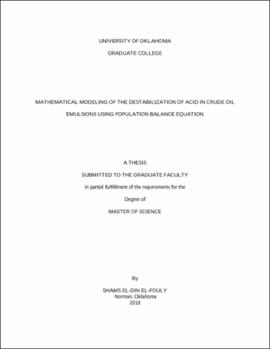| dc.contributor.advisor | Fahes, Mashhad | |
| dc.contributor.author | El-Fouly, Shams El-Din | |
| dc.date.accessioned | 2019-08-01T19:17:45Z | |
| dc.date.available | 2019-08-01T19:17:45Z | |
| dc.date.issued | 2019-08 | |
| dc.identifier.uri | https://hdl.handle.net/11244/321098 | |
| dc.description.abstract | In this current work, a phenomenological mathematical model that utilizes the population balance equation was developed to understand the destabilization process of acid in crude oil emulsions in laboratory conditions. The model considers changes due to advection, diffusion and binary coalescence of the dispersed acid phase. The model studies specifically the evolution of the droplet size distribution as a function of time for the top, next to bottom and bottom layers of a vertical cylinder. The resulting model was a nonlinear hyperbolic intergo-partial differential equation.
As with many complex mathematical models, this model required a numerical solution. The source term modeling birth and death of droplets was numerically solved using Kumar’s fixed-pivot technique and converted to a system of partial differential equations. As for the advection-diffusion transport properties, five numerical solutions were examined each suitable under certain model properties. Four of the techniques were standard upwind schemes that are second, third and fourth order accurate, and the fifth was a non-standard method. All these schemes were also optimized to reduce the numerical errors to almost negligible. The non-standard method proved to be superior to the traditionally used upwind schemes for fine and course grids and low and high Reynolds numbers.
Based on this algorithm, the numerical model was solved using initial literature experimental data for acid/oil emulsions and was able to provide a suitable prediction of droplet size distribution profiles for each of the three layers of interest in addition to both dispersed and continuous phase volumes. The model was also found to be a good predictive tool for the initial mean droplet size for early acid/oil emulsion days using an exponential regression model for each time step. The volume fraction of acid was found to be highly sensitive to changes in mean droplet size but was inconclusive in accessing the effect of standard deviation on the model evolution. The proposed algorithm has also presented evidence of the presence of a cohesive process dominating the system alongside the destabilization process of advection, diffusion and binary coalescence. | en_US |
| dc.language | en_US | en_US |
| dc.rights | Attribution 4.0 International | * |
| dc.rights.uri | https://creativecommons.org/licenses/by/4.0/ | * |
| dc.subject | Population Balance Equation | en_US |
| dc.subject | Acid Oil Emulsion | en_US |
| dc.subject | Liquid-liquid Separation Modeling | en_US |
| dc.subject | Droplet Size Distribution | en_US |
| dc.title | MATHEMATICAL MODELING OF THE DESTABILIZATION OF ACID IN CRUDE OIL EMULSIONS USING POPULATION BALANCE EQUATION | en_US |
| dc.contributor.committeeMember | Wu, Xingru | |
| dc.contributor.committeeMember | Teodoriu, Catalin | |
| dc.date.manuscript | 2019-07 | |
| dc.thesis.degree | Master of Science | en_US |
| ou.group | Mewbourne College of Earth and Energy::Mewbourne School of Petroleum and Geological Engineering | en_US |

